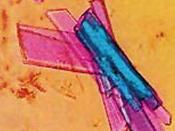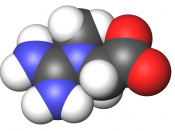Creatine is currently one of the most popular supplements among athletes today. Since creatine has only been around for a short time there has been much speculation about the long-term safety of the product. In this paper I will tell about the positive and negative effects of creatine, and why I feel the positive effects out weigh the possible negative affects. Along with this I will also provide information on how creatine works and its history.
Creatine is a natural substance that is found in the muscles of humans and animals. It's composed of three amino acids called arginine, glycine and methionine. The average person needs to consume an average of 2 grams of creatine a day. Most people will eat about 1 gram a day from meats and dairy products. The rest is produced in the body. (Natural Power Builders)
When creatine is in the body it produces Adenosine Triphosphate, or ATP.
ATP creates the energy that is used in muscle contractions. The bonds between the phosphates and the Adenosine are very strong. When they are broken, energy is released for the muscle cells to use. When ATP has been broken down it becomes Adenosine Diphosphate, or ADP. ADP alone can not produce the energy for muscle contractions. This is where creatine helps. Creatine donates its phosphate to the ADP causing it to change into ATP. The more creatine phosphate that's stored in the muscle the more rapidly the ADP converts to ATP. When the ATP supply in the body has been depleted, fatigue sets in. Since creatine helps recycle ADP to ATP quicker, one will have increased energy in their muscles and will be able to train for longer periods of time. The presence of creatine in the body is not what causes the muscles to grow and...


